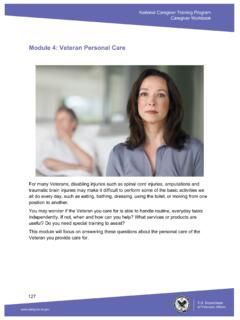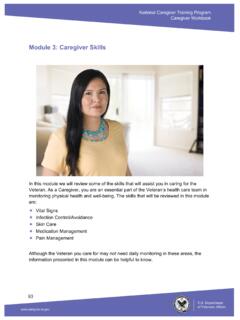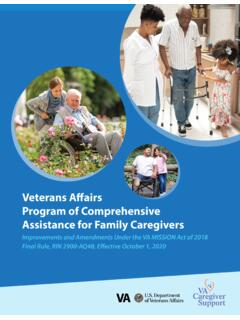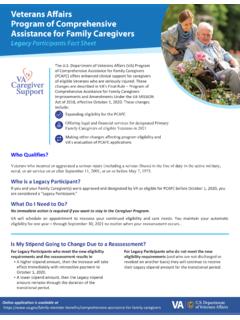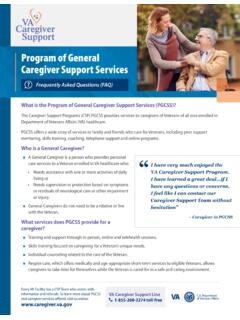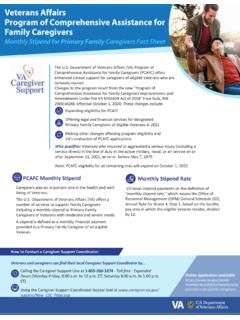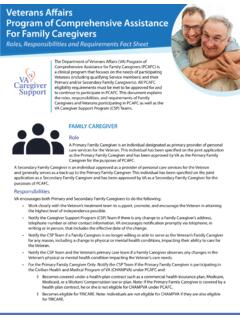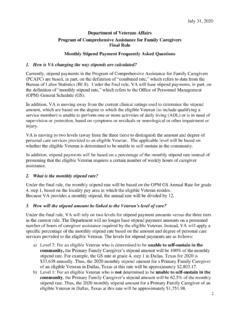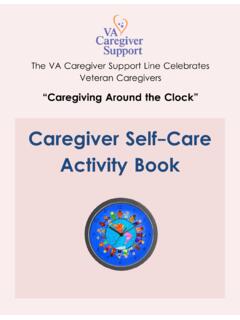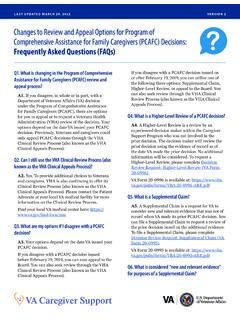Transcription of Veterans Affairs Program of Comprehensive Assistance for ...
1 Veterans Affairs Program of Comprehensive Assistance for Family Caregivers eligibility Criteria Fact Sheet The Department of Veterans Affairs (VA) Program of Comprehensive Assistance for Family Caregivers (PCAFC) offers enhanced clinical support for caregivers of eligible Veterans who are seriously injured. Changes to the Program result from the new Program of Comprehensive Assistance for Family Caregivers Improvements and Amendments Under the VA MISSION Act of 2018 Final Rule, RIN 2900-AQ48, effective October 1, 2020.
2 These changes include: Expanding eligibility for PCAFC Offering legal and financial services for designated Primary Family Caregivers of eligible Veterans in 2021 Making other changes affecting Program eligibility and VA s evaluation of PCAFC applications Who qualifies: Veterans who incurred or aggravated a serious injury (including serious illness) in the line of duty in the active military, naval, or air service on or after September 11, 2001, or on or before May 7, 1975. Veteran eligibility Requirements: The Veteran must have a serious injury, which is a single or combined service-connected disability rating of 70% or more, and meet the following eligibility requirements to participate in the Program of Comprehensive Assistance for Family Caregivers: 1 The individual is either: A Veteran.
3 Or A member of the Armed Forces undergoing a medicaldischarge from the Armed The individual has a serious injury (including serious illness) incurred or aggravated in the line of duty in the active military, naval, or air service: On or after September 11, 2001; or On or before May 7, 1975; or Effective October 1, 2022, after May 7, 1975 andbefore September 11, The individual is in need of in-person personal careservices for a minimum of six (6) continuous months based on any one of the following: An inability to perform an activity of daily living; or A need for supervision, protection, or It is in the best interest of the individual to participatein the Program .
4 5 Personal care services that would be provided by the Family Caregiver will not be simultaneously and regularly provided by or through another individual or entity. 6 The individual receives care at home or will do so if VA designates a Family Caregiver. 7 The individual receives ongoing care froma Primary Care Team or will do so if VA designates a Family Caregiver. How to Contact a Caregiver Support Coordinator: Veterans and caregivers can find their local Caregiver Support Coordinator Calling the Caregiver Support Line Expanded Hours 1-855-260-3274 (Monday-Friday, 8:00 to ET; Saturday 8:00 to 5:00 pm ET) Toll freeUsing the Caregiver Support Coordinator locator at Online applications will soon be a reality, as well.
5 Family Caregiver eligibility Requirements For you to be eligible to be a Family Caregiver you must: 1 Be at least 18 years of Be either: The eligible Veteran s spouse, son, daughter, parent,stepfamily member, or extended family member; or Someone who lives with the eligible Veteran full-timeor will do so if designated as a Family Be initially assessed by VA as being able to completecaregiver education and training. 4 Complete caregiver training and demonstrate the ability to carry out the specific personal care services, core competencies, and additional care requirements.
6 In addition, there must be no determination by VA of abuse or neglect of the eligible Veteran by the caregiver. Stipend Levels: As a Primary Family Caregiver, you may qualify to receive a monthly stipend, which is paid at one of two levels. Here are the details: 1 If a Veteran meets all seven eligibility requirements (listed above), then VA must determine whether the Veteran is unable to self-sustain in the community in order to determine the stipend level. 2 Level One: If VA determines that a Veteran is not unableto self-sustain in the community the designated Primary Family Caregiver will receive the lower-level stipend payment.
7 3 Level Two: If VA determines the Veteran is unable to self-sustain in the community the designated Primary Family Caregiver will receive the higher-level stipend payment. Unable to self-sustain in the community Definition "Unable to self-sustain in the community " means that an eligible Veteran either: Requires personal care services each time he or shecompletes three or more of the seven activities ofdaily living (ADL) listed in the definition of aninability to perform an activity of daily living in thissection, and is fully dependent on a caregiver tocomplete such ADLs.
8 Or Has a need for supervision, protection, orinstruction on a continuous to Perform Activity of Daily Living (ADL) The inability to perform an ADL means the Veteran or service member requires personal care services each time he or she completes one or more of the ADLs listed below. Dressing or undressing oneself Bathing Grooming oneself in order to keep oneself cleanand presentable Adjusting any special prosthetic or orthopedicappliance, that by reason of the particular disabilitycannot be done without Assistance (this does notinclude the adjustment of appliances that nondisabledpersons would be unable to adjust without aid, such assupports, belts, lacing at the back, etc.)
9 Toileting or attending to toileting Feeding oneself due to loss of coordination of upperextremities, extreme weakness, inability to swallow, orthe need for a non-oral means of nutrition Mobility (walking, going up stairs, transferring frombed to chair, etc.)Requiring Assistance with an ADL only some of the time does not meet the definition of an "inability to perform an ADL." A Need for supervision, protection, or instruction A "need for supervision, protection, or instruction" means the Veteran or service member has a functional impairment that directly impacts their ability to maintain his or her personal safety on a daily basis Updated 11/30/20
